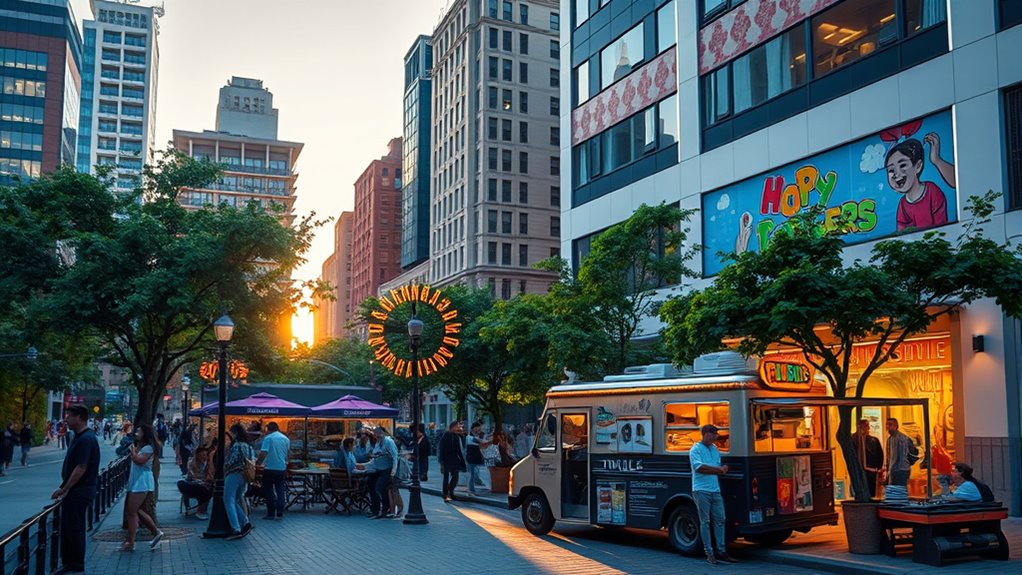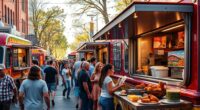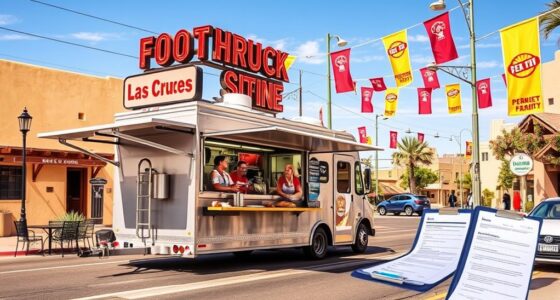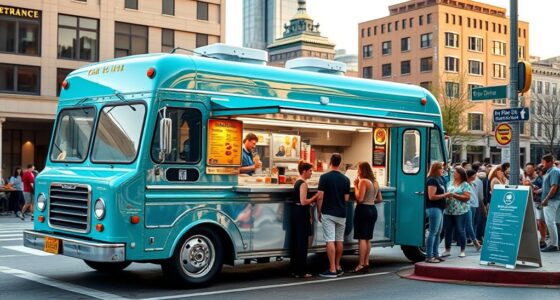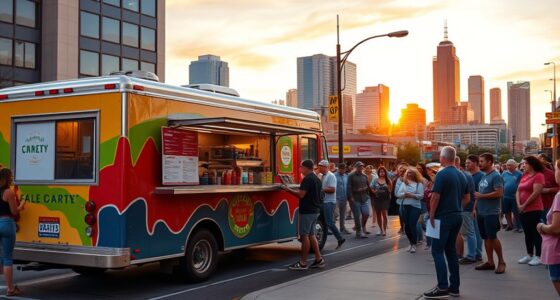To find the best spots for food truck sales, focus on areas with high foot traffic like busy parks, university campuses, and near transit hubs. Look for existing food truck clusters or popular event venues to maximize exposure. Consider local regulations, permits, and nearby competition. Position yourself where visibility and accessibility are ideal during peak hours. Want to discover more strategies to choose your prime location? Keep exploring to get expert insights.
Key Takeaways
- Identify high-traffic areas like city centers, parks, and near educational institutions during peak hours.
- Analyze existing food truck clusters and popular event venues to find proven customer hotspots.
- Ensure locations are accessible via transit stops, parking lots, and support infrastructure for quick service.
- Align truck placements with scheduled events, sports games, and community fairs for increased foot traffic.
- Obtain necessary permits and licenses, and consider local regulations to operate legally and sustainably.
Analyzing Population Density and Pedestrian Traffic
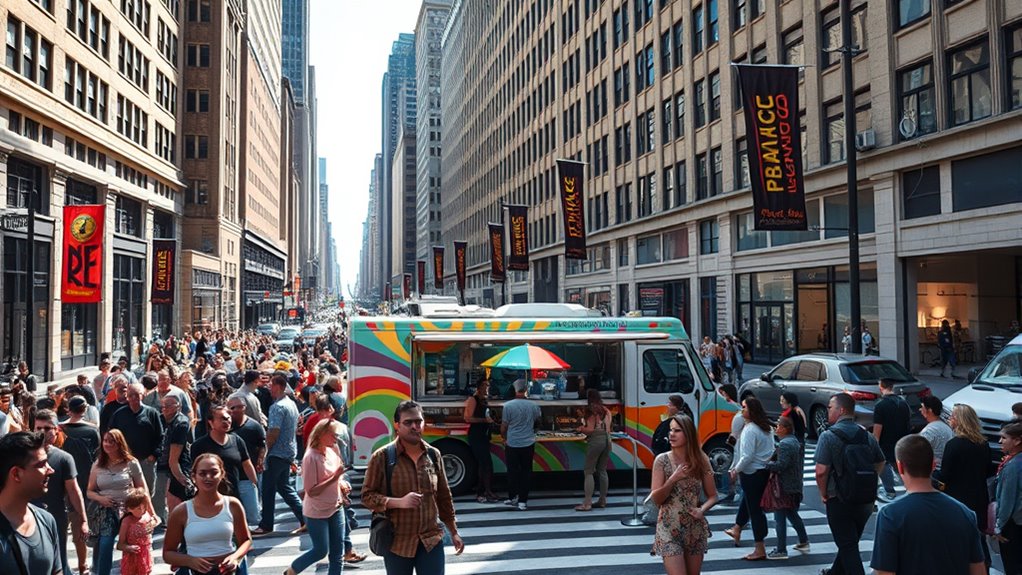
Analyzing population density and pedestrian traffic is essential for identifying prime locations for food trucks. Higher population density boosts your potential customer base, especially in dense urban areas with workers, residents, and tourists. Keep in mind, census data may not fully capture your actual audience, as many customers are commuters or visitors. Areas with mixed-use developments—residential and commercial—offer steady pedestrian flow throughout the day, which benefits food trucks. Demographic shifts like gentrification can alter neighborhood profiles, affecting demand and pricing strategies. To maximize success, combine population density data with pedestrian pathways and points of interest. Look for spots with high foot traffic, such as transit hubs, shopping districts, or busy plazas, where people naturally gather and are more likely to buy from your truck. Incorporating visual cues or signage can also help attract attention in busy areas.
Identifying Existing Food Truck Clusters and Parks
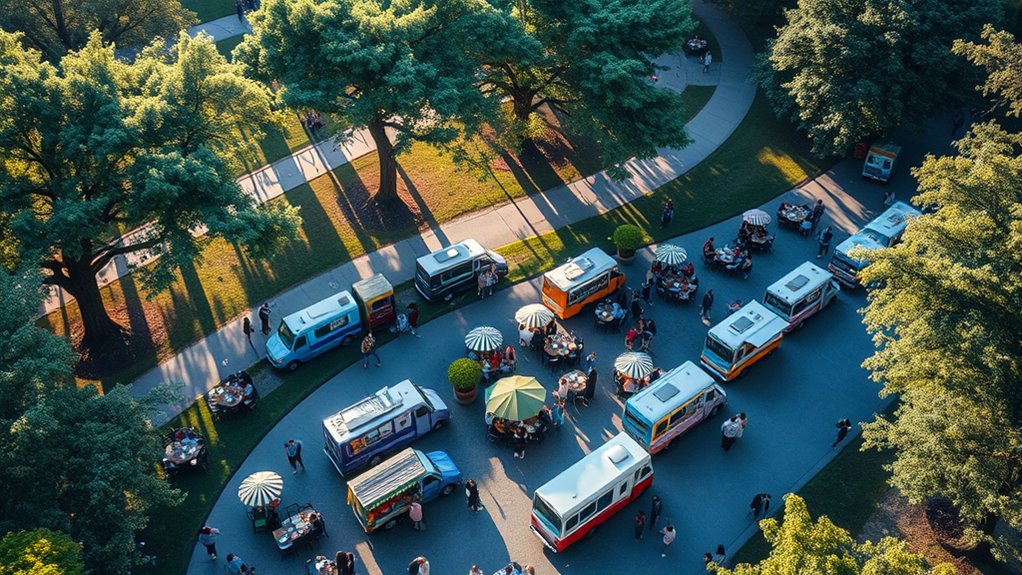
Discovering where food trucks already gather can considerably boost your chances of success. Food truck clusters are often found in city centers with relaxed regulations, encouraging vendor density. For example, Washington, D.C.’s Farragut Square attracts many trucks and crowds, especially during peak hours. Urban parks and plazas serve as natural hubs, leveraging seating and gathering spots to draw customers. These clusters typically form near transit stations, tourist attractions, and cultural districts, maximizing exposure. City-designated food truck parks also facilitate multiple vendors operating under permits, creating lively, diverse food scenes. Analyzing existing clusters and parks helps you identify high-traffic areas where demand is proven. Researching local regulations and permits can help you enter these areas more easily. Additionally, examining successful food truck programs and their locations can provide valuable insights into areas with proven customer interest. By focusing on these established hubs, you position yourself where customers already gather, increasing your chances of sustained sales and growth.
Targeting High-Traffic Commercial and Office Areas
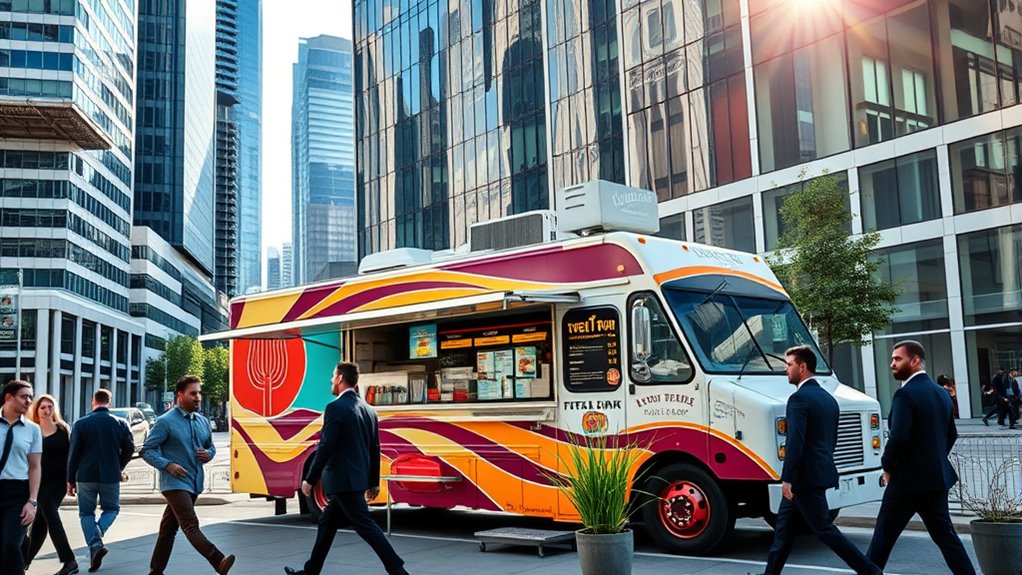
To attract steady customers, focus on locations close to office entrances and main walkways where workers pass by frequently. Arranging your truck near busy commercial hubs during peak hours guarantees you’re visible when employees are looking for quick lunches. Being accessible and strategically positioned can make all the difference in boosting your sales in high-traffic office areas. Check local regulations and permits to ensure parking in these areas is legal and compliant, preventing potential disruptions or fines. Additionally, understanding foot traffic patterns can help you choose optimal spots that maximize customer exposure and sales.
Proximity to Office Buildings
Proximity to office buildings is essential for food truck success in busy commercial areas. Office buildings host hundreds or thousands of employees daily, creating a reliable customer base. Employees often look for quick, diverse lunch options beyond cafeterias or packed meals, boosting demand for food trucks nearby. High-density office neighborhoods see regular foot traffic, especially during lunch and break times, making them prime locations. Food trucks benefit from being close to office parks and medical campuses, where dining options are limited. However, local regulations vary; some cities impose restrictions on how close trucks can park, affecting site choices. Areas with flexible zoning laws, like Portland or Philadelphia, make it easier to operate in these high-traffic office zones, maximizing sales opportunities. Additionally, proximity to public transit hubs can increase customer flow, as many commuters seek convenient dining options during their workday.
Accessibility During Peak Hours
Maximizing accessibility during peak hours is essential for food trucks targeting high-traffic commercial and office areas. To do this effectively, focus on locations with high pedestrian flow during busy times. Here are key strategies:
- Position near transit stops or parking lots that serve commercial zones to improve customer access without being directly next to offices.
- Ensure easy entry and exit for vehicles to speed up service and reduce congestion during peak periods.
- Time your service windows to align with pedestrian rushes, such as lunch breaks (11 AM-2 PM) and dinner hours (5 PM-8 PM), when foot traffic peaks.
- French fries and potatoes are among the most popular menu items in 2024, so consider offering these to attract more customers during peak times.
- Regularly monitor retail hours and local regulations to adapt your schedule and location for optimal accessibility.
Additionally, stay compliant with city regulations to avoid restrictions that could limit accessibility. These tactics help maximize sales while maintaining smooth operations during busy hours.
Nearby Commercial Hubs
Targeting high-traffic commercial and office areas can considerably boost your food truck sales by attracting a steady flow of potential customers. Locations near business parks, downtown financial districts, and corporate campuses draw large daytime crowds seeking quick, convenient meals. These areas often have diverse tenant mixes, offering multiple customer profiles and increasing sales opportunities. Proximity to conference centers and coworking spaces can create high-demand spikes during meetings or events. Keep in mind, local regulations may restrict parking or require permits, so check zoning laws and property agreements beforehand. Infrastructure like electricity, water, and nearby parking make setups easier, while sidewalks and seating enhance customer experience. Differentiating your menu with healthy options or specialty offerings helps stand out amid competition in busy commercial hubs. According to recent industry data, the number of food truck businesses has been steadily increasing, indicating growing opportunities in these locations. Additionally, understanding urban zoning laws and compliance can prevent potential legal issues and ensure smooth operations.
Leveraging Proximity to Educational Institutions and Event Venues

Placing your food truck near educational institutions and event venues puts you right in the path of high foot traffic and impulse buyers. You can capitalize on students’ quick lunch breaks and lively event schedules to boost sales and build a loyal customer base. Choosing strategic spots with visible, easy access guarantees you’ll attract the crowds looking for convenient, tasty options. Trailer music can be an effective way to create an inviting atmosphere or attract attention to your location, especially if you’re hosting special events or promotions. Food trucks offer diverse menu options that cater to student preferences and increase the likelihood of repeat visits.
College Campus Foot Traffic
College campuses attract high foot traffic around main quads, student centers, and dining halls during peak meal times, making these areas prime spots for food trucks. You should focus on these high-traffic zones where students naturally gather. To optimize your location, consider these factors:
- Position near classroom buildings, libraries, or recreational hubs where students congregate.
- Ensure your truck is highly visible to capitalize on impulse purchases—avoid hidden spots.
- Place your truck close to seating areas, trash cans, and shelter to increase dwell time and comfort.
- Peak hours vary based on class schedules, breaks, and campus growth, so timing your presence during busy periods is essential. Choosing spots that align with these patterns maximizes your chances of attracting hungry students and boosting sales. Additionally, selecting locations with diverse designs can help your food truck stand out amidst the busy campus environment.
Event Scheduling Opportunities
Scheduling your food truck around educational institutions and event venues can considerably boost sales by aligning your presence with high-traffic times and gatherings. Events like orientation weeks or sports games draw large crowds, creating prime opportunities for quick, convenient meals. For eating-focused events, expect about one truck per 200–300 guests; for less food-centric gatherings, about one per 400–500 guests. Timing is key—set up during event start and break times to maximize customer flow. Collaborating with event organizers or venue managers streamlines approval and scheduling. Consider these visual cues:
| Event Type | Typical Crowd Size | Ideal Setup Time |
|---|---|---|
| Sports Game | 1,000+ | Half-hour before game |
| Cultural Fair | 300–500 | During peak hours |
| School Fundraiser | 200–400 | During breaks |
| Concert | 1,000+ | During intermission |
Knowing attendance numbers(1) helps plan the number of trucks needed to meet demand, ensuring you are not under- or over-prepared for the crowd size. Additionally, understanding event planning strategies can further optimize your scheduling and sales.
Strategic Location Placement
Maximizing your food truck’s visibility requires strategic placement near high-traffic educational institutions and lively event venues. Being close to campuses or event spaces turns your truck into an informal social hub, encouraging students and event-goers to stop by. To optimize your location, consider these factors:
- Position near busy campus areas like library entrances or bus stops to catch spontaneous buyers.
- Locate spots with steady pedestrian flow, such as grassy areas or picnic spots, that foster social gatherings.
- Set up near campus sports or event facilities to attract crowds without relying solely on class schedules.
- Food trucks create a festive, engaging atmosphere, attracting students with music and a different vibe, which can be amplified by strategic placement.
- Additionally, choosing locations with nearby water parks can boost foot traffic, especially during peak seasons when visitors are looking for convenient food options after enjoying water attractions.
Navigating Permitting and Licensing Requirements
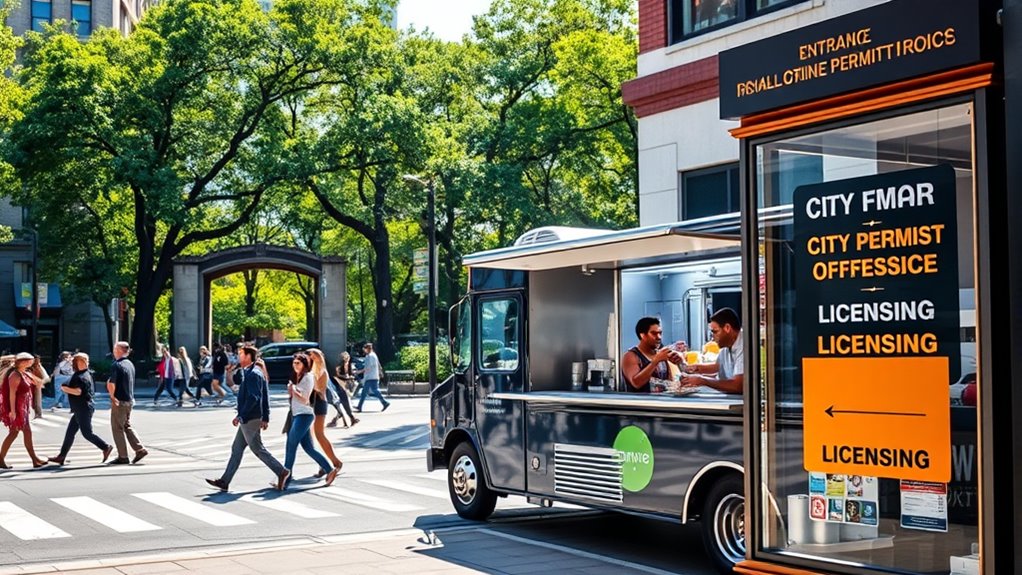
Navigating permitting and licensing requirements is a crucial step in launching your food truck business, as regulations can vary widely depending on your location. You’ll need a business license, usually obtained through the Secretary of State or local city hall, and a mobile food vendor permit from health or business departments. The health department permit requires passing inspections and adhering to food safety standards, with inspection costs from $100 to $1,000. You’ll also need a Food Handler’s Permit, costing about $7–$15, and often a Seller’s Permit for sales tax collection. Regulations differ by city and state, including operating hours, zoning, and licensing for out-of-state trucks. Planning ahead guarantees you meet all requirements and avoid costly delays or penalties. Researching local laws ensures you are fully compliant with all applicable regulations before starting operations. Additionally, understanding regulatory variability across different jurisdictions can help you better prepare for compliance challenges.
Evaluating Accessibility to Supply and Infrastructure Services
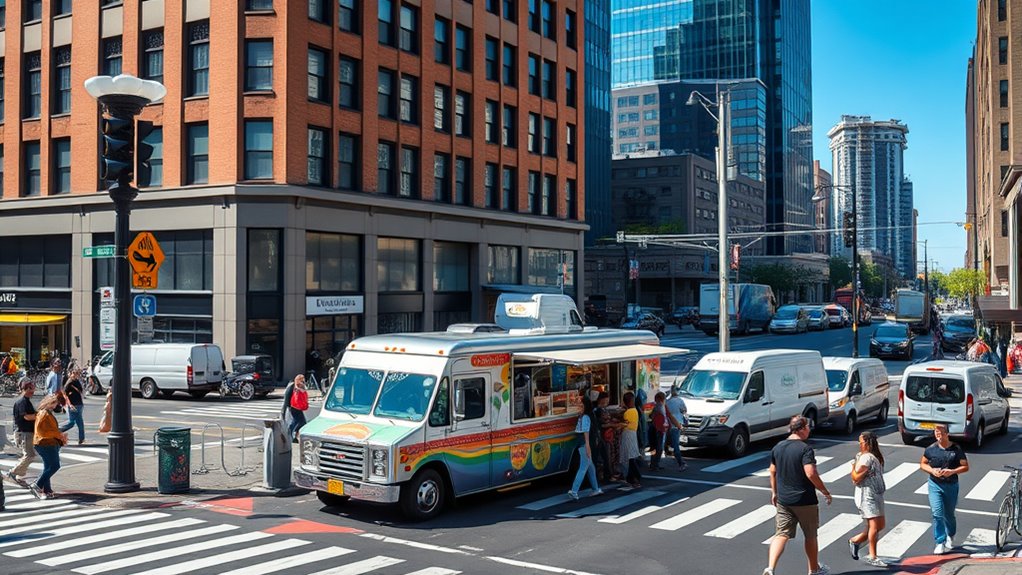
Evaluating accessibility to supply and infrastructure services is essential for ensuring smooth daily operations of your food truck. First, check that water sources are approved public supplies, with proper pressure and food-grade tanks, hoses, and sanitation procedures. Second, ensure wastewater and waste disposal systems are reliable, with tanks sized at least 15% larger than your water supply, and that disposal sites are accessible for safe, compliant discharge. Third, confirm nearby commissaries or support facilities offer essential services like waste management, storage, and utilities—parking and drive lanes should facilitate easy access. Additionally, reliable utilities are vital for consistent operation, helping to prevent unexpected disruptions. Incorporating sound design principles can also improve communication systems and alert mechanisms within your setup, ensuring safety and efficiency. These factors help maintain food safety standards, streamline operations, and avoid health violations. Being close to reliable infrastructure means fewer disruptions, better compliance, and increased efficiency for your business.
Considering Local Regulations and Tax Implications
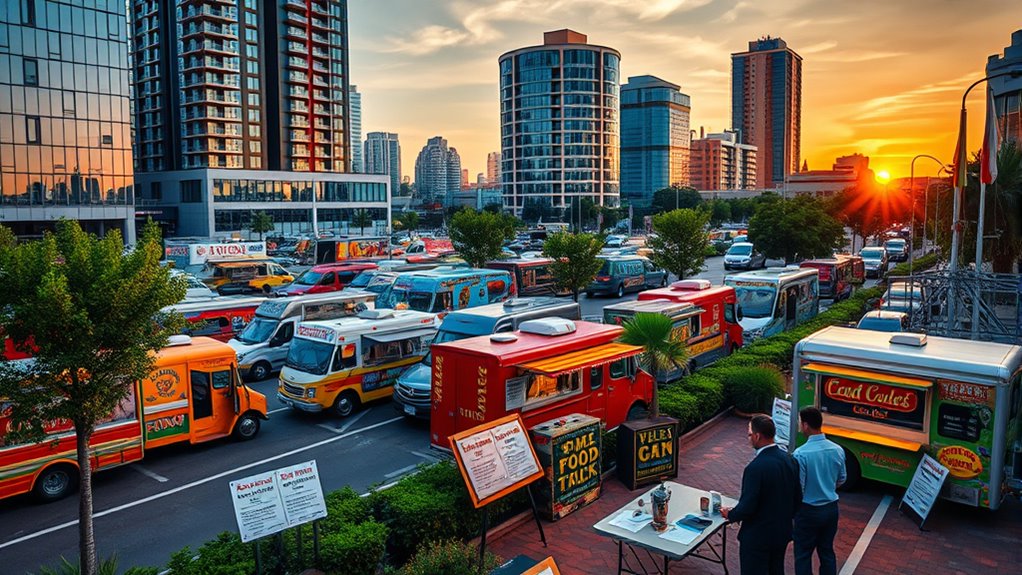
Before choosing a location, you need to understand local regulations and tax rules. Permits, licensing requirements, and sales tax rates can vary widely and impact your operations. Ensuring compliance helps you avoid fines, closures, and unexpected expenses that could hurt your business. Costs for permits and licenses can differ significantly depending on where you operate, so researching these expenses beforehand is essential. Additionally, understanding community engagement strategies can help you select high-traffic spots that attract more customers.
Permit and Licensing Ease
The ease of obtaining permits and licenses for food trucks varies considerably across different jurisdictions, making it essential to research local regulations thoroughly. 1. Licensing processes differ by state and city, with business licenses costing $50–$400 and mobile food permits sometimes exceeding $1,000 annually. 2. Some areas have limited permit availability, leading to waitlists, as seen in places like New York City, which can delay your plans. 3. Additional permits such as health, food handler, and seller’s permits may cost between $100 and $1,000, depending on the location. Navigating these requirements requires careful planning, as some jurisdictions impose strict paperwork, fees, and wait times. Understanding local licensing complexities upfront helps you avoid surprises and guarantees smooth entry into your chosen markets. Additionally, researching Forsale 100 opportunities for equipment or vehicle sales in your area can help reduce initial costs and streamline your startup process.
Sales Tax Rates
Sales tax rates can substantially impact your food truck’s pricing and profitability, especially since they vary widely across states and local jurisdictions. Most states tax prepared foods, including those sold from trucks, often at the same rate as dine-in restaurants. However, some states differentiate between grocery items and prepared foods, applying lower or no taxes to essentials. Local jurisdictions frequently add additional sales taxes, further complicating compliance. Traveling food trucks must track multiple rates and rules to properly collect and remit taxes in each area. You can choose to include sales tax in your menu prices or add it at checkout, but you need to follow local regulations. Accurate tax collection is essential to avoid penalties, and using tax automation tools can simplify managing multi-jurisdictional rates. Understanding relevant laws and regulations is crucial for compliance and optimizing your pricing strategy.
Regulatory Restrictions
Are local regulations shaping where and how you can operate your food truck? They definitely impact your choices. Here are some key restrictions to contemplate:
- Relocation Rules: Many municipalities require moving your truck every 10-30 minutes, mainly to prevent new regulations and avoid congestion. These rules are often enforced through designated zones or time limits. Additionally, understanding the licensing and registration requirements is crucial to ensure compliance and avoid penalties.
- Proximity Limits: Regulations often restrict operating near schools or brick-and-mortar restaurants to protect established businesses.
- Safety Standards: Rules on truck height, service side orientation, fire safety (like fire suppression systems), and trash disposal prioritize safety but can limit your setup options.
You’ll also need to navigate licensing, registration, and zoning laws. Understanding these regulations helps you choose locations where you can operate smoothly and avoid penalties.
Exploring Opportunities at Festivals and Community Events

Have you considered festivals and community events as prime opportunities to boost your food truck’s visibility and revenue? These gatherings attract large crowds, with events like the Fort Smith Food Truck Festival expecting growth, and the Black Food Truck Festival drawing over 15,000 attendees in 2022. Vendors see high sales, averaging nearly $8,000 per event, and enjoy a 95% satisfaction rate, encouraging repeat participation. Nearly half of food truck customers discover vendors at festivals, with millennials being a key demographic, many returning after positive experiences. These events generate significant economic impact, creating jobs and stimulating local spending on lodging, food, and transportation. Participating in festivals also helps diversify your customer base, enhances brand recognition, and aligns your offerings with current culinary trends. Additionally, 2024’s festival attendance of approximately 394 people demonstrates the potential for growth and increased exposure at upcoming events. Incorporating event marketing strategies can further maximize your success at these gatherings.
Assessing Competition and Complementary Business Locations
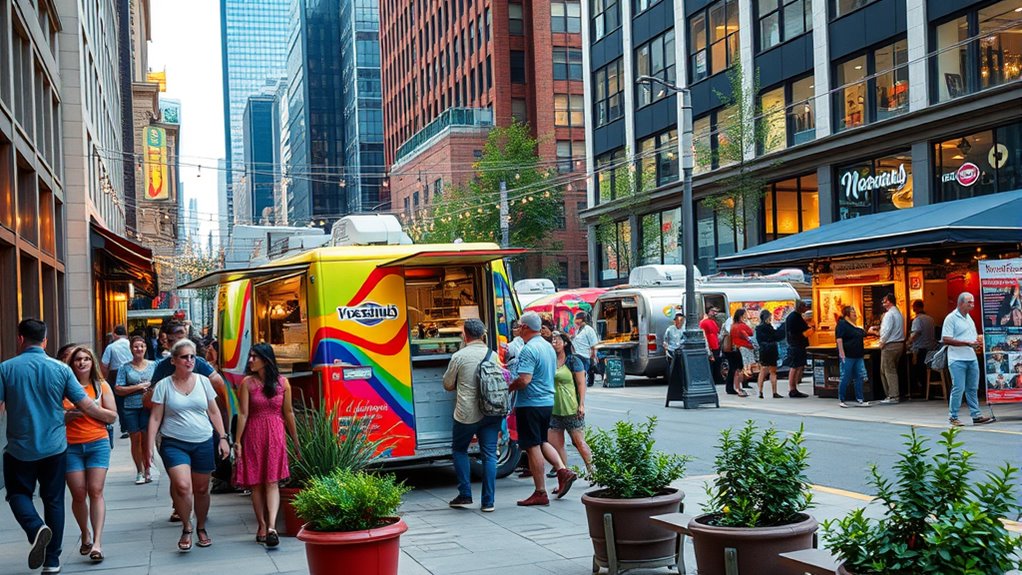
To maximize your food truck’s success, it’s essential to evaluate both direct and indirect competitors within your target area. Start by mapping out competitors’ locations to identify overlaps or gaps and understand their service styles—whether they’re walk-up, drive-thru, or seating-based. Next, analyze their menus and pricing to spot unique dishes, discounts, or trending options you can capitalize on. Finally, assess their branding and marketing efforts, including social media activity, visual identity, and event participation, to gauge their market presence. Here’s what to focus on:
- Mapping competitors’ locations and service styles to identify crowded or underserved areas.
- Cataloging menu offerings and prices to differentiate your truck.
- Reviewing competitors’ branding and marketing tactics for insights into customer engagement.
- Evaluating color accuracy in promotional materials and signage to ensure your branding appears vibrant and appealing to attract customers.
Utilizing Data and Trends for Strategic Site Selection
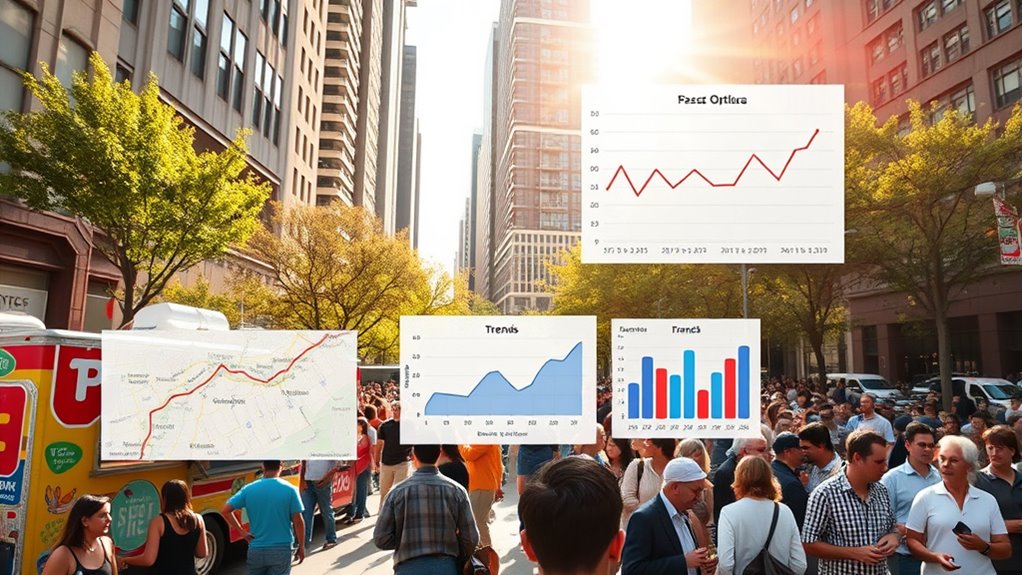
Harnessing data and trends is essential for making informed site selection decisions that boost your food truck’s profitability. Analyzing sales and traffic data helps you identify peak hours, often aligning with downtown lunch breaks, so you can maximize sales during busy periods. Catering events like corporate functions or festivals can generate up to 70% of your revenue, making them predictable sites. Real-time POS systems enable you to monitor foot traffic and transaction volumes, revealing high-traffic areas. Demographic trends guide you toward neighborhoods with demand for upscale, health-conscious, or plant-based options. Digital tools and social media analytics pinpoint trending locations, while understanding local regulations assures compliance. Combining these data sources allows you to choose sites that attract the right customers at the right times. Additionally, understanding butter’s artistic influence can inspire unique marketing visuals or themed food presentations that stand out in competitive markets.
Frequently Asked Questions
How Can I Identify Emerging Food Truck Hotspots Before They Become Popular?
To spot emerging food truck hotspots early, you should analyze foot traffic data from mobile devices and city sensors to find rising activity zones. Keep an eye on social media geotags and hashtags for trending areas. Monitor local events, new developments, and delivery platform demand. Partner with community groups, attend farmers markets, and stay updated on city regulations. Using AI and predictive tools helps forecast neighborhood growth and ideal selling times.
What Are the Best Ways to Build Relationships With Local Event Organizers?
Building relationships with local event organizers is like planting seeds for a flourishing garden. You should research their reputations online and talk to fellow vendors for insights. Attend events early to network, and communicate clearly about your needs and expectations. Offer to collaborate on marketing efforts and show appreciation for their work. Consistently reliable service and respectful communication help nurture trust, leading to long-term, mutually beneficial partnerships.
How Do Seasonal Variations Affect Food Truck Location Strategies?
Seasonal variations greatly impact your food truck’s location strategy. You should shift your spots based on seasonal events, weather, and foot traffic patterns. During warmer months, target outdoor festivals and busy parks, while in colder seasons, focus on sheltered areas and indoor events. Adjust your hours to match peak customer times, like lunch or evening, and capitalize on seasonal holidays and festivals to maximize sales and visibility year-round.
What Tools Are Available to Analyze Foot Traffic Data Effectively?
Did you know sensors and heatmaps can increase your foot traffic insights by up to 30%? To analyze foot traffic data effectively, you can use tools like sensors, heatmaps, GPS, and AI-powered video analytics, which track visitor patterns accurately. Integrating this data via dashboards helps you see trends, optimize locations, and make real-time decisions. Wearable device data and interactive offers also enhance engagement, boosting your food truck’s success.
How Can I Assess the Long-Term Viability of a Potential Food Truck Location?
To assess a location’s long-term viability, you should analyze foot traffic consistency and demand patterns, considering seasonal changes and local events. Evaluate demographics to verify your target market aligns. Check accessibility, parking, and utility options for smooth operations. Review past sales data, monitor customer satisfaction, and calculate profitability considering all costs. Use mapping tools and real-time sales info to adapt your strategy and confirm the location’s potential for sustained success.
Conclusion
By choosing the right locations, you can turn your food truck into an unstoppable culinary force. Analyze foot traffic, tap into busy areas, and stay ahead of trends to maximize your success. Remember, your placement choices are the secret sauce to dominating the market—miss it, and you risk blending into the background like a forgotten flavor. With strategic planning, you’ll turn every spot into a feast for your business and a delight for your customers.
